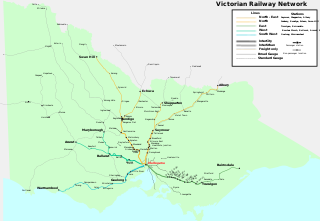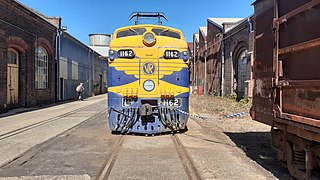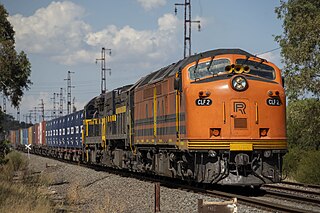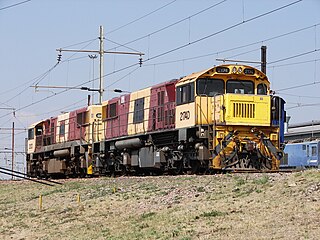| V/Line N Class | |||||||||||||||||||||||||||||||
|---|---|---|---|---|---|---|---|---|---|---|---|---|---|---|---|---|---|---|---|---|---|---|---|---|---|---|---|---|---|---|---|
 N458 on a Swan Hill service to Southern Cross speeds past Sunbury, September 2020. | |||||||||||||||||||||||||||||||
| |||||||||||||||||||||||||||||||
| |||||||||||||||||||||||||||||||
| |||||||||||||||||||||||||||||||
| |||||||||||||||||||||||||||||||
The N Class are a class of diesel locomotives built by Clyde Engineering in Somerton for V/Line between 1985 and 1987.
| V/Line N Class | |||||||||||||||||||||||||||||||
|---|---|---|---|---|---|---|---|---|---|---|---|---|---|---|---|---|---|---|---|---|---|---|---|---|---|---|---|---|---|---|---|
 N458 on a Swan Hill service to Southern Cross speeds past Sunbury, September 2020. | |||||||||||||||||||||||||||||||
| |||||||||||||||||||||||||||||||
| |||||||||||||||||||||||||||||||
| |||||||||||||||||||||||||||||||
| |||||||||||||||||||||||||||||||
The N Class are a class of diesel locomotives built by Clyde Engineering in Somerton for V/Line between 1985 and 1987.







By the start of the 1980s, Victorian Railways passenger numbers had fallen to around 3 million per year, due to ageing rolling stock, stagnant timetables and competition from other forms of transport. The Lonie Report of 1980 recommended sweeping cuts to the network, but there was a strong push from the many quarters for the state government to maintain a viable rail network. The government response in February 1981 was the New Deal for Country Passengers , a $115 million commitment to recast country rail passenger services in Victoria. [1]
As part of the New Deal, all B class locomotives were to be re-built as the A class for use on passenger services, and ten new locomotives were ordered. Tenders closed in 1983, with Clyde Engineering being awarded the contract. [2] By mid-1985, the rising cost of the A class conversions led to the project being abandoned after 11 locomotives had been upgraded, and the N class order was increased to 25, using parts intended for the A class conversions. [1] [3]
The N class locomotives entered service on the 1,600 mm (5 ft 3 in) gauge and operated on main lines all over the state, with the exception of the Gippsland line beyond Traralgon, a restriction that was later lifted. The class also saw regular use on The Overland Melbourne to Adelaide overnight service until the train was withdrawn in March 1995 so that the track could be converted to 1,435 mm (4 ft 8+1⁄2 in) standard gauge. [2] As well as being operated by V/Line, N class locomotives were hired to the Warrnambool line operator, West Coast Railway, from 1993 to 1995, after which its own locomotives became available, [4] and, between 1993 and 2004, to Shepparton line operator Hoys Roadlines. [5]
In preparation for the privatisation of V/Line, the operations of V/Line Freight and V/Line Passenger were split in 1995, [6] with the N class allocated to the passenger operator and included in the sale of V/Line Passenger to National Express in 1999. [7] Before then, N class locomotives had been employed on freight services, restricted to a maximum speed of 90 km/h (56 mph). [2]
During the Regional Fast Rail project, a number of shut-downs were affected passenger services, and N class locomotives were used to haul ballast trains on the Geelong line in 2003 and 2004, [8] as well as being hired to Freight Australia in January 2004 to haul log and grain services. [9] After 2007, class members were also been hired to heritage operator Seymour Railway Heritage Centre for use on its trains, because the provision of TPWS equipment on the locos allowed them to run at full line speed over the Regional Fast Rail network. [10] [11]
With the gradual introduction of VLocity diesel multiple unit trains, N class locomotives began to play a lesser role, their main use being to haul peak-time commuter services to Bacchus Marsh and Geelong, along with long-distance services beyond the Regional Fast Rail network, to Bairnsdale, Swan Hill, and Warrnambool. A standard gauge variation also ran Albury services, but they were replaced by standard gauge VLocitys. The last standard gauge N class service ran on 30 July 2022.
On March 2024, for the first time since 2004, four N class locomotives were hired to Southern Shorthaul Railroad to haul freight trains. In preparation for leasing to SSR, the PTV and V/Line logos were stripped out. The first freight train with an N Class locomotive was hauled on 16 March 2024 on a grain train. It could be expected that the N Class locomotives could replace the aging B Class locomotives in the SSR fleet.
N class locomotives are authorised to operate at 115 km/h (71 mph), although some units have been upgraded with D77/78 traction motors and have a maximum speed of 130 km/h (80 mph). [12] By June 2020, all locomotives had been fitted with the upgraded traction motors. [13]
N class locomotives have a locally designed frame and body, fitted with imported Electro-Motive Division technology in the prime mover, generator and control unit, along with locally produced components such as the bogie frames, constructed by Bradken. The class was the first in the world to use the EMD D43 traction motor, similar to, but smaller than, that used in the C and G classes. Head end power is provided by a separate engine unit in a special compartment located at the number 1 end of the locomotive, behind the electrical cabinet. The 240 kW generator provides 415 V 3-phase AC power for train lighting, air conditioning and other carriage requirements. [2]
Fitted with 6,800-litre fuel tanks, the class were capable of running from Melbourne to Adelaide without refuelling. [14] Electrical and electronic components were modular, to minimise delays after failures, and a reactive muffler system reduced the exhaust noise level. While most of the locomotives have only been used on broad gauge, three were converted to 1,435 mm (4 ft 8+1⁄2 in) standard gauge by exchanging the wheelsets and repositioning the braking equipment. [2]
The narrow car body provided for a catwalk along each side, between the cabs, with fold-back body panels for maintenance access. The cab is similar to that of the G class locomotives, with an anti-climber beam to prevent upward movement should a collision occur. Twin high-impact windscreens were provided, with dual blade wipers. Each cab had room for a two-person crew, as well as an instructor if required. Air conditioning was provided, as well as an air-operated retention toilet at one end, accessible from the catwalk. The locos were initially provided with automatic staff exchange equipment, but that was removed in the 1990s, after the use of the electric staff ended, although the space remains in the cab side. [2]
The car body design was the basis of one-off locomotive, GML10, built by Clyde Engineering in 1990 for the Goldsworthy railway. [15]
The N class locomotives were delivered in the V/Line tangerine orange and grey livery, and named after cities in Victoria, except for N453, which is named after the City of Albury in New South Wales. The N class is, therefore, one of only three Australian locomotive classes of which every class member is named. [16] N465 carries the earlier spelling of Ballarat, originally Ballaarat. On 10 March 1987, locomotive N470 was returned to Clyde Engineering, Somerton for a ceremony, at which brass plaques were affixed at both ends under the builder's plates, reading "V/Line locomotive N470 completes 2-million horse-power of diesel electric locomotives built by Clyde Engineering in Australia 10 March 1987". [17]
From 1995, the class members were repainted into the new V/Line red and blue livery, and the V/Line logo on the side was altered after the privatisation of V/Line in 1999. [3] In a program started in 2007 N class locos received white stripes along the cab-fronts, and their cowcatchers were painted yellow, to increase visibility at level crossings .
In May 2008, locomotive N468 was repainted into the new V/Line livery of red with grey, white and yellow. Three of the repainted locos were converted to 1,435 mm (4 ft 8+1⁄2 in) standard gauge in 2011, following the conversion of the North East line. [18] [19]
On 8 April 2017, N457 made its first revenue run to Albury in the new PTV livery of purple and yellow. That followed the painting of carriage set SN 8 into the new livery to match the V/Locity fleet, and style of the wider fleet of Victorian trams and buses

| Locomotive | Name | Serial no. | Traction Motors | Max Speed Km/h | Entered service | Owner | Operator | Gauge | Livery | Notes |
|---|---|---|---|---|---|---|---|---|---|---|
| N451 | City of Portland | 85-1219 | D77/78 | 130 | 20 September 1985 | V/Line Passenger | V/Line Passenger | 1,435 mm (4 ft 8½ in) standard gauge | Purple/Yellow 'PTV' | Stored South Dynon |
| N452 | Rural City of Wodonga | 85-1220 | D77/78 | 115 | 10 October 1985 | V/Line Passenger | V/Line Passenger | 1,600 mm (5 ft 3 in) broad gauge | Purple/Yellow 'PTV' | |
| N453 | City of Albury | 85-1221 | D77/78 | 130 | 1 November 1985 | V/Line Passenger | V/Line Passenger | 1,600 mm (5 ft 3 in) broad gauge | Purple/Yellow 'PTV' | |
| N454 | City of Horsham | 85-1222 | D77/78 | 130 | 20 November 1985 | V/Line Passenger | V/Line Passenger | 1,600 mm (5 ft 3 in) broad gauge | Purple/Yellow 'PTV' | Stored Geelong |
| N455 | City of Swan Hill | 85-1223 | D77/78 | 130 | 19 December 1985 | V/Line Passenger | Southern Shorthaul Railroad [19] | 1,600 mm (5 ft 3 in) broad gauge | Purple/Yellow 'PTV' | Stored Southern Cross Rail Yards |
| N456 | City of Colac | 85-1224 | D77/78 | 115 | 29 January 1986 | V/Line Passenger | V/Line Passenger | 1,600 mm (5 ft 3 in) broad gauge | Purple/Yellow 'PTV' | |
| N457 | City of Mildura | 85-1225 | D77/78 | 130 | 27 February 1986 | V/Line Passenger | V/Line Passenger | 1,435 mm (4 ft 8½ in) standard gauge | Purple/Yellow 'PTV' | Stored South Dynon |
| N458 | City of Maryborough | 85-1226 | D77/78 | 130 | 17 March 1986 | V/Line Passenger | V/Line Passenger | 1,600 mm (5 ft 3 in) broad gauge | Purple/Yellow 'PTV' | |
| N459 | City of Echuca | 85-1227 | D77/78 | 130 | 15 April 1986 | V/Line Passenger | V/Line Passenger | 1,600 mm (5 ft 3 in) broad gauge | Purple/Yellow 'PTV' | Stored Geelong |
| N460 | City of Castlemaine | 85-1228 | D77/78 | 130 | 15 May 1986 | V/Line Passenger | V/Line Passenger | 1,600 mm (5 ft 3 in) broad gauge | Purple/Yellow 'PTV' | |
| N461 | City of Ararat | 85-1190 | D77/78 | 115 | 25 July 1986 | V/Line Passenger | V/Line Passenger | 1,600 mm (5 ft 3 in) broad gauge | Purple/Yellow 'PTV' | |
| N462 | City of Shepparton | 86-1191 | D77/78 | 115 | 14 August 1986 | V/Line Passenger | V/Line Passenger | 1,600 mm (5 ft 3 in) broad gauge | Purple/Yellow 'PTV' | |
| N463 | City of Bendigo | 86-1192 | D77/78 | 130 | 4 September 1986 | V/Line Passenger | Southern Shorthaul Railroad [19] | 1,600 mm (5 ft 3 in) broad gauge | Purple/Yellow 'PTV' | The locomotive that the runaway Broadmeadows Train collided into |
| N464 | City of Geelong | 86-1193 | D77/78 | 130 | 29 September 1986 | V/Line Passenger | Southern Shorthaul Railroad [19] | 1,600 mm (5 ft 3 in) broad gauge | Purple/Yellow 'PTV' | |
| N465 | City of Ballaarat | 86-1194 | D77/78 | 130 | 20 October 1986 | V/Line Passenger | V/Line Passenger | 1,600 mm (5 ft 3 in) broad gauge | Purple/Yellow 'PTV' | Uses traditional spelling of Ballarat |
| N466 | City of Warrnambool | 86-1195 | D77/78 | 115 | 31 October 1986 | V/Line Passenger | Southern Shorthaul Railroad [19] | 1,600 mm (5 ft 3 in) broad gauge | Purple/Yellow 'PTV' | |
| N467 | City of Stawell | 86-1196 | D77/78 | 130 | 26 November 1986 | V/Line Passenger | V/Line Passenger | 1,600 mm (5 ft 3 in) broad gauge | Purple/Yellow 'PTV' | |
| N468 | City of Bairnsdale | 86-1197 | D77/78 | 130 | 19 December 1986 | V/Line Passenger | V/Line Passenger | 1,600 mm (5 ft 3 in) broad gauge | Purple/Yellow 'PTV' | |
| N469 | City of Morwell | 86-1198 | D77/78 | 130 | 29 January 1987 | V/Line Passenger | V/Line Passenger | 1,435 mm (4 ft 8½ in) standard gauge | Purple/Yellow ‘PTV’ | Stored South Dynon |
| N470 | City of Wangaratta | 86-1199 | D77/78 | 130 | 17 February 1987 | V/Line Passenger | V/Line Passenger | 1,600 mm (5 ft 3 in) broad gauge | Purple/Yellow 'PTV' | Stored Geelong |
| N471 | City of Benalla | 87–1200 | D77/78 | 130 | 28 February 1987 | V/Line Passenger | V/Line Passenger | 1,600 mm (5 ft 3 in) broad gauge | Purple/Yellow 'PTV' | |
| N472 | City of Sale | 87-1201 | D77/78 | 130 | 27 March 1987 | V/Line Passenger | V/Line Passenger | 1,600 mm (5 ft 3 in) broad gauge | Purple/Yellow 'PTV' | Stored Geelong |
| N473 | City of Warragul | 87-1202 | D77/78 | 130 | 28 April 1987 | V/Line Passenger | V/Line Passenger | 1,600 mm (5 ft 3 in) broad gauge | Purple/Yellow 'PTV' | |
| N474 | City of Traralgon | 87-1203 | D77/78 | 130 | 28 May 1987 | V/Line Passenger | V/Line Passenger | 1,600 mm (5 ft 3 in) broad gauge | Purple/Yellow 'PTV' | |
| N475 | City of Moe | 87-1204 | D77/78 | 130 | 6 July 1987 | V/Line Passenger | V/Line Passenger | 1,600 mm (5 ft 3 in) broad gauge | Purple/Yellow 'PTV' | Stored Southern Cross Rail yards |





Rail transport in the Australian state of Victoria is provided by a number of railway operators who operate over the government-owned railway lines. The network consists of 2,357 km of Victorian broad gauge lines, and 1,912 km of standard gauge freight and interstate lines; the latter increasing with gauge conversion of the former. Historically, a few experimental 762 mm gauge lines were built, along with various private logging, mining and industrial railways. The rail network radiates from the state capital, Melbourne, with main interstate links to Sydney and to Adelaide, as well as major lines running to regional centres, upgraded as part of the Regional Fast Rail project.

The Victorian Railways (VR), trading from 1974 as VicRail, was the state-owned operator of most rail transport in the Australian state of Victoria from 1859 to 1983. The first railways in Victoria were private companies, but when these companies failed or defaulted, the Victorian Railways was established to take over their operations. Most of the lines operated by the Victorian Railways were of 5 ft 3 in. However, the railways also operated up to five 2 ft 6 in narrow gauge lines between 1898 and 1962, and a 4 ft 8+1⁄2 instandard gauge line between Albury and Melbourne from 1961.

The Spirit of Progress was the premier express passenger train on the Victorian Railways in Australia, running from Melbourne to the New South Wales border at Albury, and later through to Sydney.
The North East railway line is a railway line in Victoria, Australia. The line runs from Southern Cross railway station on the western edge of the Melbourne central business district to Albury railway station in the border settlement of Albury-Wodonga, serving the cities of Wangaratta and Seymour, and smaller towns in northeastern Victoria.

The 81 class are a class of diesel locomotives built by Clyde Engineering, Kelso for the State Rail Authority.

The 442 class are a class of diesel locomotives built by AE Goodwin and Comeng, Auburn for the New South Wales Department of Railways between 1970 and 1973.

The Victorian Railways L class was a class of electric locomotives built by English Electric and operated by the Victorian Railways and later V/Line from 1953 until 1987 primarily on the Gippsland line. They were the only class of main line electric locomotive operated in Victoria.

The A class are a class of diesel locomotives rebuilt from Victorian Railways B class locomotives by Clyde Engineering, Rosewater in South Australia for V/Line in 1984–1985.

The B class are a class of diesel locomotives built by Clyde Engineering, Granville for the Victorian Railways in 1952–1953. Ordered and operated by the Victorian Railways, they initiated the dieselisation of the system and saw use on both passenger and freight services, with many remaining in service today, both in preserved and revenue service. Some were rebuilt as the V/Line A class, while others have been scrapped.

The DRC was a class of railmotor operated by the Victorian Railways on its country rail network in Victoria, Australia. The cars were built by Tulloch Limited in New South Wales, and featured aluminium and steel construction, air-conditioning, and twin diesel engines with hydraulic transmissions.

The C Class are a class of diesel locomotive built by Clyde Engineering, Rosewater for the Victorian Railways in 1977–1978.

The S class are a class of diesel locomotives built by Clyde Engineering, Granville for the Victorian Railways between 1957 and 1961.

The P class are a class of diesel locomotives rebuilt from T class locomotives by Clyde Engineering, Somerton for V/Line in 1984–1985.

The GT46C is a model of diesel-electric locomotive designed and built by Clyde Engineering using Electro-Motive Diesel components. A number of Australian rail freight operators purchased them from 1997: Westrail as the Q class, FreightLink as the FQ class, and Freight Australia as the single-locomotive V class. As of 2022, all 24 locomotives were owned by Aurizon following its purchase of certain One Rail Australia assets in July 2022.

The X class are a class of mainline diesel locomotives built by Clyde Engineering, Granville and Rosewater for the Victorian Railways between 1966 and 1976.

The T class are a class of diesel locomotives built by Clyde Engineering, Granville for the Victorian Railways between 1955 and 1968.

The G Class are a class of diesel locomotive built by Clyde Engineering, Rosewater and Somerton for V/Line between 1984 and 1989.

The N type carriages are an intercity passenger carriage used on the railways of Victoria, Australia. They were introduced between 1981 and 1984 as part of the 'New Deal' reforms of country passenger rail services. Today they are seen on both V/Line long distance InterCity services, and limited commuter services to Geelong.

The CL class is a class of diesel locomotives built by Clyde Engineering, Granville for the Commonwealth Railways in several batches between 1970 and 1972. The class was the last in the world to be built with the Electro-Motive Diesel bulldog nose but differed from previous builds in having a mansard roof.

The Queensland Railways 2170 class is an Australian diesel-electric locomotive.
![]() Media related to V/Line N class at Wikimedia Commons
Media related to V/Line N class at Wikimedia Commons